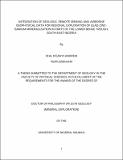UNNSpace Repository
Integration of Geologic, Remote Sensing and Airborne Geophysical Data for Regional Exploration of Lead-Zinc-Barium Mineralization in Parts of the Lower Benue Trough, South-East Nigeria
- UNNSpace Home
- →
- Faculty of Physical Sciences
- →
- Geology
- →
- Theses and Dissertations (Geology)
- →
- View Item
JavaScript is disabled for your browser. Some features of this site may not work without it.
| dc.contributor.author | Oha, Ifeanyi Andrew
|
|
| dc.date.accessioned | 2017-03-17T14:44:18Z | |
| dc.date.available | 2017-03-17T14:44:18Z | |
| dc.date.issued | 2017-03-17 | |
| dc.identifier.uri | http://hdl.handle.net/123456789/4053 | |
| dc.description.abstract | The unavailability of comprehensive mineral occurrence database and reliable mineral potential map for the lead-zinc-barite (Pb-Zn-Ba) mineralization of the Lower Benue Trough, may have contributed to the lack of interest of big investors in harnessing the resources that have been known for over 70 years. This work is aimed at reassessing the Pb-Zn-Ba potential of the Lower Benue Trough in the light of new high resolution data and improved technology and based on information generated, produce a reliable mineral potential map for the area. Geologic, structural, remotely sensed and airborne geophysical data were assembled and analyzed using appropriate software. Various digital image processing routine were applied to Landsat7 ETM+ data yielding image outputs which includes edge enhanced images, colour composites, band ratios, principal component composites and normalized difference vegetation index (NDVI) from which lithologic and structural information were extracted. Recently acquired high resolution airborne geophysical data were analyzed using Geosoft’s Oasis Montaj. Various processed grids including vertical and horizontal gradients, analytical signal, reduction to pole (RTP), 3D-Euler deconvulation and source parameter imaging (SPI) were generated in order to extract structural and depth information. Ternary, radioelement composites, and radioelement ratios were also used to extract lithologic and alteration information. The various interpreted image layers were exported into ArcGIS 9.3 for data integration and GIS analyses Information gathered from field work in four mineralized locations which include, Ishiagu, Enyigba, Wanikande-Wanakom and Gabu-Oshina areas reveal that mineralization is restricted to NW-SE and N-S trending fractures hosted in a wide variety of rocks. Apart from the Enyigba area, igneous bodies are found in the vicinity of the ore deposits and in the Wanikande area, barite veins and veinlets were observed to be closely interwoven with intrusive bodies. The ore assemblage varies remarkably, with Pb:Zn:Ba ratios varying from approximately 3:1:0 at Ishiagu, to 2:1:0 at Enyigba, 1:0:2 at Wanikande and nearly 100% barite at Gabu-Oshina. Thus there is a remarkable increase in barite content from the southwest (Ishiagu) to the northeast (Gabu). A total of 1126 lineaments were extracted from the filtered Landsat data and 529 lineaments from the aeromagnetic data. Statistical trend analysis shows identical dominant NE-SW trends for both data, however the subordinate NW-SE and N-S trends observed in the Landsat data are greatly diminished in the aeromagnetic data. Rock alterations which may be related to mineralization were mapped from both the Landsat data and airborne radiometric data, with their effect in both cases observed around known mineralized area. Vertical derivatives, 3D-Euler and Source Parameter Imaging (SPI) reveal the existence of large volumes of igneous bodies either outcropping or at depths of less than 200m. Visual delineation led to the identification of six magmatic centres in the area, which put together makes up about 60% of the study area with depth to basement in the deeper parts of the basin ranging from 2.2 – 4.8km. A hybrid of knowledge driven and data driven GIS models is applied utilizing the powerful transparency tool in ArcGIS to generate a Pb-Zn-Ba favourability map. Five potential targets were identified from the favourability map, which together with the known mineralized areas occupy a total area of 3,110Km2 which is about 12% of the study area. | en_US |
| dc.language.iso | en | en_US |
| dc.subject | Geophysical data | en_US |
| dc.subject | Lead-zinc-barium | en_US |
| dc.subject | Mineral Potential Map | en_US |
| dc.title | Integration of Geologic, Remote Sensing and Airborne Geophysical Data for Regional Exploration of Lead-Zinc-Barium Mineralization in Parts of the Lower Benue Trough, South-East Nigeria | en_US |
| dc.type | Thesis | en_US |
